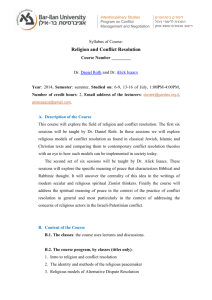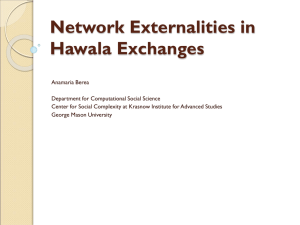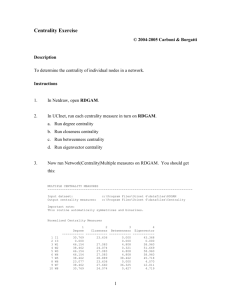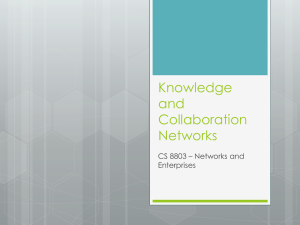Manju Ahuja Revisiting Communication and Trust in Globally Distributed Teams: A Social
advertisement
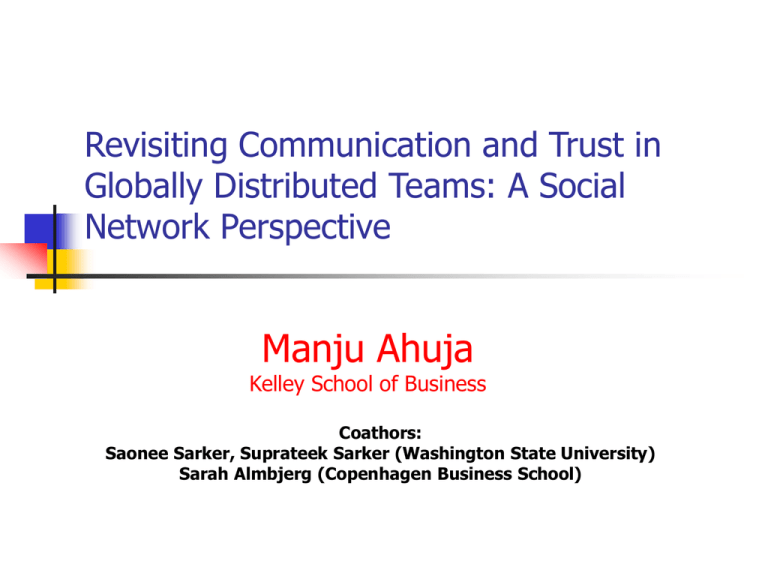
Revisiting Communication and Trust in Globally Distributed Teams: A Social Network Perspective Manju Ahuja Kelley School of Business Coathors: Saonee Sarker, Suprateek Sarker (Washington State University) Sarah Almbjerg (Copenhagen Business School) Agenda State of knowledge on globally distributed teams The theorized relationships among communication, trust, and performance Communication and Trust from a Social Network Perspective Research Methodology Findings Discussion Research on Trust in VTs Key areas of research in globally distributed teams Trust (e.g., Jarvenpaa, Shaw, and Staples 2004; Piccoli and Ives, 2003; Sarker, Valacich, and Sarker 2003) Communication (e.g., Piccoli, Powell, and Ives 2004; Galvin and Ahuja 2001; Jarvenpaa and Leidner 1998) “The most widely researched of the issues surrounding virtual teams” (Powell et al. 2004, p. 17) Trust is Generally a dependent variable Research in virtual teams Focus on group performance Need to investigate individual performance (Mehra et al. 2001) Need to identify the high performing team members (e.g., Powell et al. 2004) Reliance primarily on individual trait-based or sometimes behavior-based explanations Need structural/relational approach (Tichy 1981) Research on the structural position of individuals can answer “why are some people better performers than others” (Mehra et al. 2001) RESEARCH QUESTION What is the role of communication and trust centrality in determining an individual’s performance within a globally distributed team? The approach - “networked individualism.” Networked Individualism Noted researchers have observed that ICTmediated groups are moving towards “networked individualism” (Wellman et al. 2003) “By bringing to bear measures and constructs of social structure, we can begin to how simple notions of .. autonomous individuals are incomplete” (Rice 1994, p. 181) “Networked Individualism” (contd.) “If you took away my computer, my colleagues, my office, my books, my desk, my telephone I wouldn’t be a sociologist writing papers, delivering lectures, and producing knowledge. I’d be something quite other – and the same is true for all of us.” (Law 1992) Virtual Teams as a Social Network We conceptualize a distributed team as a social network, and each individual having a structural position within that network. Communication& Trust-based Stru. Position Performance Three Models We explore three perspectives regarding the nature of influence of trust and communication on individual performance in globally distributed teams They represent three Strands of Theorizing about the role of Communication and Trust an additive model an interaction model, and A mediation model. The Additive Model Twin predictions concerning performance One preditcs a strong linkage between trust and performance (Hossain and Wigand 2004; Coppola, Hiltz, and Rotter 2004) “Prevailing view of trust in the IS literature contends that trust has direct positive effects on .. performance” (e.g., Iacono and Weisband 1997; Jarvenpaa and Leidner 1999)” The other predicts that “Ineffective communications,” may “hinder” performance (Scarnati 2001) Trust Individual Performance Communication The Interaction Model Model suggests that both trust and communication are necessary for higher individual performance That is, trust and communication interact to affect outcome (Jarvenpaa et al. 2004) E.g., team member may be perceived as a low performer by peers if he/she exhibits low communication and does not enjoy the trust of other members (Jarvenpaa et al. 2004) Trust Communication Individual Performance The Mediation Model Any effect of communication on performance is due to trust Communication leads to trust, and trust leads to performance (Coppola, Hiltz, and Rotter 2004). “Trust is developed through communication” (Handfield 1994) “High levels of trust will cause the trustor .. to perceive good performance” (Jarvenpaa et al. 2004) “Several empirical studies on the trust development process suggest that video and audio.. are nearly as good as face-to-face contacts provided that participants engage in various gettingacquainted activities..” (Hossain and Wigand 2004) Communication Trust Individual Performance Ego-centric Network View Communication Centrality Trust Centrality The extent to which a member is communicatively connected with each of the other members within a team The extent to which a member enjoys the trust of each of the other members within a team (trustworthiness) Degree-based Communication Centrality Legend: Blue nodes: Location A team members Red nodes: Location B team members Size of nodes: Communication centrality Trust Centrality Legend: Blue nodes: Location A team members Red nodes: Location B team members Size of nodes: Trust centrality Research Methodology A field study of hybrid virtual teams Sample US-Norway student teams engaged in systems development US-Denmark student teams engaged in systems analysis Duration: 1 semester Duration: 6 weeks N=111 Measures In-degree centrality In-degree centrality is relatively stable even at a low sampling level (Valente and Davis 1999) Freeman’s (1979) measure of relative in-degree centrality (i.e., the actual number of lines relative to the total number that it could sustain) was used Performance “.. the effects of networks on performance.. measured by supervisor ratings, may contain political aspects” (Brass 2003) Consistent with the above comment, each team member was asked to rate the performance of every other team member Analysis Technique Additive Model Interaction Model Linear Regression Hierarchical Regression (Mehra et al. 2001) Mediation Model Linear Regression following the guidelines of Baron and Kenney (1986) Results - Additive Model Model Summary Effect of communication (b = .001, p> .10) Effect of Trust (b = .519, p < .05) R-square = .646 Results fail to support the Additive Model Interaction Model Model Summary 1st block with communication centrality and trust centrality as predictors (R-square = .646, 2nd model R-square = .781) 2nd block included the above predictors and an additional interaction term R-square change is .134 (F-change is significant) The ANOVA model (1st Model (F= 98.736, p < .01), 2nd Model (F= 126.85, p< .01, Role of communication (b= -.064, p> .10), role of trust (b= .562, p< .01), role of interaction (b= -.444, p< .01) 2nd Model has better fit. However, direction of the interaction is anomalous Mediation Model Model Summary (Baron and Kenney, 1986) Commun. centrality affects trust centr. (b= .832, p<.01) Commun. centrality affects performance (b= .432, p< .01) Trust centrality affects performance (b= .519, p< .01) and effect of commun. centrality disappears (b= .001, p> .10) Thus, full mediation exists (Baron and Kenney 1986) Results support the mediation model Discussion Complete mediation of trust on the relationship between communication and performance That is, high levels of communication cannot lead to high performance until he/she is trusted by the other team members ‘More [communication] is not always better” (Krackhardt and Hansen 2003) What about the anomaous Moderation Model? To understand anomalous moderating model, we split the sample into High trust centrality Low trust centrality In hi-trust group, the interaction effect is positive; negative in the low-trust group Less trustworthy members are harmed by more communication Possible effect of task? No! We split the sample into: those involved in systems analysis tasks (US-Denmark), & those involved in systems development tasks (US-Norway) Results are consistent, showing robustness Continuing Research Continuing to qualitatively explore the three models Initial exploration supports regression results Questions?

